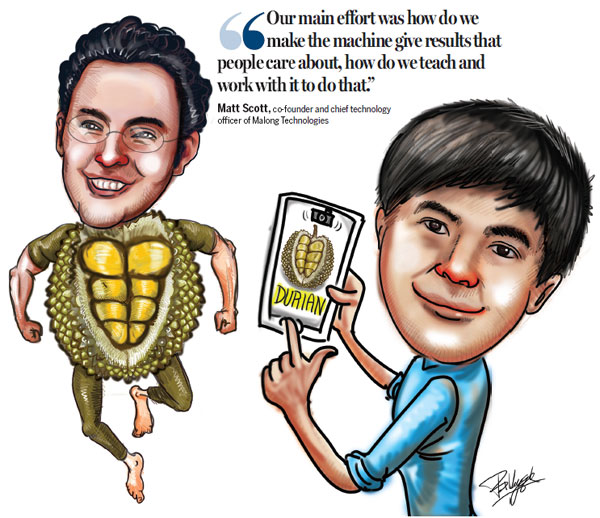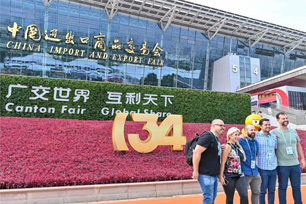'Magician' StyleAI presents a world of design ideas

Editor's note:
The StyleAI smart app from Shenzhen-based AI startup Malong Technologies, founded by an ex-Microsoft duo, takes everyday objects around us and offers on-the-spot design inspiration.What would it be like if everyday things around us turned into design inspirations for new fashions? A pastel-blue scarf with white polka dots reflecting the sky and white clouds, a glittering golden dress that echoed the opulent Royal Palace of Phnom Penh, Cambodia, or even a multi-colored backpack reminiscent of a delicious hamburger with layers of bacon, lettuce and tomato?
What if every corner of the earth could be represented through fashion? Millions of new fashion ideas could be born. People's aesthetic tastes - their love for the sea, mountains or flowers - could be translated into different fashion styles. That is what a transnational duo is dedicated to bringing to the world.
At first glance, it seems hard to associate Shenzhen native Huang Dinglong and New Yorker Matt Scott with fashion. Dressed in casual T-shirts, the two fashion entrepreneurs are in fact techies with years of experience in leading technology companies.
The pair got to know each other when they both worked for Microsoft in Beijing, Scott at Microsoft Research Asia and Huang at MSN, and often exchanged views on the latest trends in technological development. They first worked together to develop an English/Chinese dictionary web service called Engkoo, which has now become the Bing dictionary.
"One day, we were sitting in a restaurant next to where Matt got married, chatting, and the idea (of combining technology and fashion) suddenly broke out. I was so excited that I could not fall asleep," recalls Huang, 34.
Far from being far-fetched, their idea was feasible. The rapid expansion of e-commerce has created a huge number of online buyers eager to seek out stylish and distinctive clothes, and an enormous Internet database makes it possible to dig out all the pictures related to various facets of fashion.

"If we could create a product that was able to stimulate people's desire to buy things, then it was going to make business value," said Huang.
He and Scott immediately embarked on a project to develop an artificial intelligence (AI) software product that would be able to identify fashion items and inspire fashion ideas. They named it StyleAI.
Take a photo of any fashion item - a dress, a hat or accessories - through StyleAI, and the smart app will recognize it and show the exact item or similar ones with their price tags, enabling fashionistas to find their choices quickly.
It can also act like a magician and "conjure up" attire of various similar patterns in a second, based on any picture, whether it is of a natural landscape or modern architecture, thanks to the massive data on fashion.
"It is a zero-to-one innovation. We had no previous examples to follow," said Huang, co-founder and chief executive officer of Malong Technologies.
The core difficulty was training the machine to return results or output data that people would expect it to, explained Scott, co-founder and also chief technology officer of the Shenzhen-based startup.
"If you just ask a machine to learn something, it may learn it in a way that only machines care about. Our main effort was how do we make the machine give results that people care about, how do we teach and work with it to do that," he elaborated.
Research and development was tough and intense. They started their journey from a cafe in Beijing and later moved into a humble office that was previously used as a storage room. The startup team was then selected to work in the Beijing-based Microsoft Ventures Accelerator, a platform where startups are provided with working space, entrepreneurial guidance and a chance to get to know investors. They grew fast there, and won second place in the team contest under the Internet and mobile Internet industry category at the 2014 China Innovation & Entrepreneurship Competition.
Earlier this year, the company secured 12 million yuan ($1.9 million) from angel investors. Huang said the money will mainly be used for personnel costs and in improving the functions of StyleAI, which was officially launched on Nov 18.
Though StyleAI falls into the software domain, Huang believes there is ample room for its integration with hardware products, like robots, wearable devices and drones.
"In terms of mechanical properties, Shenzhen's robotic companies are doing quite well. But when it comes to the intelligent (robotics) part, there is much room for improvement," said Huang.
"For example, it may be easy to ask a robot to dance for you. But if you ask the robot to get an apple, it may not know what an apple is and AI is able to solve this problem."
Spying the opportunity, Huang and Scott recently moved their office from Beijing to Shenzhen, as they believe the sound industry chain in hardware at the Guangdong business hub will pave the way for the company's future growth.
The development of AI technology is also expected to have a significant impact on traditional industries, with wide application in national defense, medical treatment, agriculture, finance, education and other fields, say industry experts.
"It will trigger the creation of new business models and deepen reform in the structure of industries," Tan Tieniu, vice chairman of the Chinese Association for Artificial Intelligence, told an industry conference in Beijing in July.
According to a recent report by the Taiwan-based Topology Research Institute, the market value of AI is expected to increase almost 10 times within five years, from $200 million this year to more than $2 billion by 2020.
Despite explosive growth in business expected in the industry, Huang and Scott's idea is rather simple: to discover beautiful fashion products hidden in the big, big world. And that is the reason why StyleAI was born.
sally@chinadailyhk.com
(HK Edition 12/03/2015 page8)



 Print
Print Mail
Mail

